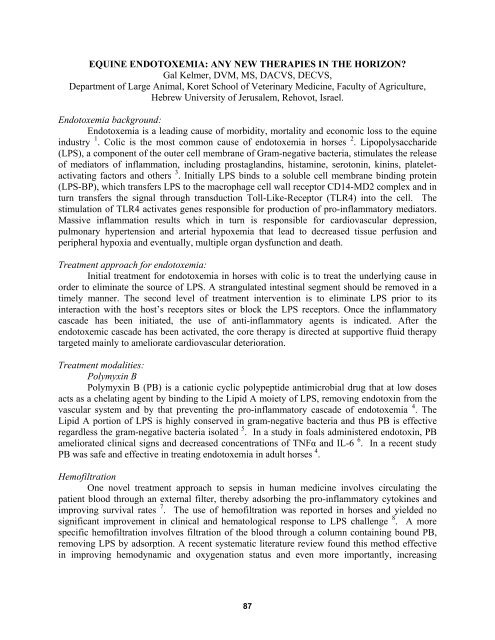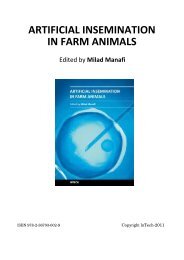equine endotoxemia: any new therapies in the horizon? - Phenix-Vet
equine endotoxemia: any new therapies in the horizon? - Phenix-Vet
equine endotoxemia: any new therapies in the horizon? - Phenix-Vet
Create successful ePaper yourself
Turn your PDF publications into a flip-book with our unique Google optimized e-Paper software.
EQUINE ENDOTOXEMIA: ANY NEW THERAPIES IN THE HORIZON?Gal Kelmer, DVM, MS, DACVS, DECVS,Department of Large Animal, Koret School of <strong>Vet</strong>er<strong>in</strong>ary Medic<strong>in</strong>e, Faculty of Agriculture,Hebrew University of Jerusalem, Rehovot, Israel.Endotoxemia background:Endotoxemia is a lead<strong>in</strong>g cause of morbidity, mortality and economic loss to <strong>the</strong> <strong>equ<strong>in</strong>e</strong><strong>in</strong>dustry 1 . Colic is <strong>the</strong> most common cause of <strong>endotoxemia</strong> <strong>in</strong> horses 2 . Lipopolysaccharide(LPS), a component of <strong>the</strong> outer cell membrane of Gram-negative bacteria, stimulates <strong>the</strong> releaseof mediators of <strong>in</strong>flammation, <strong>in</strong>clud<strong>in</strong>g prostagland<strong>in</strong>s, histam<strong>in</strong>e, seroton<strong>in</strong>, k<strong>in</strong><strong>in</strong>s, plateletactivat<strong>in</strong>gfactors and o<strong>the</strong>rs 3 . Initially LPS b<strong>in</strong>ds to a soluble cell membrane b<strong>in</strong>d<strong>in</strong>g prote<strong>in</strong>(LPS-BP), which transfers LPS to <strong>the</strong> macrophage cell wall receptor CD14-MD2 complex and <strong>in</strong>turn transfers <strong>the</strong> signal through transduction Toll-Like-Receptor (TLR4) <strong>in</strong>to <strong>the</strong> cell. Thestimulation of TLR4 activates genes responsible for production of pro-<strong>in</strong>flammatory mediators.Massive <strong>in</strong>flammation results which <strong>in</strong> turn is responsible for cardiovascular depression,pulmonary hypertension and arterial hypoxemia that lead to decreased tissue perfusion andperipheral hypoxia and eventually, multiple organ dysfunction and death.Treatment approach for <strong>endotoxemia</strong>:Initial treatment for <strong>endotoxemia</strong> <strong>in</strong> horses with colic is to treat <strong>the</strong> underly<strong>in</strong>g cause <strong>in</strong>order to elim<strong>in</strong>ate <strong>the</strong> source of LPS. A strangulated <strong>in</strong>test<strong>in</strong>al segment should be removed <strong>in</strong> atimely manner. The second level of treatment <strong>in</strong>tervention is to elim<strong>in</strong>ate LPS prior to its<strong>in</strong>teraction with <strong>the</strong> host’s receptors sites or block <strong>the</strong> LPS receptors. Once <strong>the</strong> <strong>in</strong>flammatorycascade has been <strong>in</strong>itiated, <strong>the</strong> use of anti-<strong>in</strong>flammatory agents is <strong>in</strong>dicated. After <strong>the</strong>endotoxemic cascade has been activated, <strong>the</strong> core <strong>the</strong>rapy is directed at supportive fluid <strong>the</strong>rapytargeted ma<strong>in</strong>ly to ameliorate cardiovascular deterioration.Treatment modalities:Polymyx<strong>in</strong> BPolymyx<strong>in</strong> B (PB) is a cationic cyclic polypeptide antimicrobial drug that at low dosesacts as a chelat<strong>in</strong>g agent by b<strong>in</strong>d<strong>in</strong>g to <strong>the</strong> Lipid A moiety of LPS, remov<strong>in</strong>g endotox<strong>in</strong> from <strong>the</strong>vascular system and by that prevent<strong>in</strong>g <strong>the</strong> pro-<strong>in</strong>flammatory cascade of <strong>endotoxemia</strong> 4 . TheLipid A portion of LPS is highly conserved <strong>in</strong> gram-negative bacteria and thus PB is effectiveregardless <strong>the</strong> gram-negative bacteria isolated 5 . In a study <strong>in</strong> foals adm<strong>in</strong>istered endotox<strong>in</strong>, PBameliorated cl<strong>in</strong>ical signs and decreased concentrations of TNFα and IL-6 6 . In a recent studyPB was safe and effective <strong>in</strong> treat<strong>in</strong>g <strong>endotoxemia</strong> <strong>in</strong> adult horses 4 .HemofiltrationOne novel treatment approach to sepsis <strong>in</strong> human medic<strong>in</strong>e <strong>in</strong>volves circulat<strong>in</strong>g <strong>the</strong>patient blood through an external filter, <strong>the</strong>reby adsorb<strong>in</strong>g <strong>the</strong> pro-<strong>in</strong>flammatory cytok<strong>in</strong>es andimprov<strong>in</strong>g survival rates 7 . The use of hemofiltration was reported <strong>in</strong> horses and yielded nosignificant improvement <strong>in</strong> cl<strong>in</strong>ical and hematological response to LPS challenge 8 . A morespecific hemofiltration <strong>in</strong>volves filtration of <strong>the</strong> blood through a column conta<strong>in</strong><strong>in</strong>g bound PB,remov<strong>in</strong>g LPS by adsorption. A recent systematic literature review found this method effective<strong>in</strong> improv<strong>in</strong>g hemodynamic and oxygenation status and even more importantly, <strong>in</strong>creas<strong>in</strong>g871
endotoxemic patients is overwhelmed and dysfunctional, AB adm<strong>in</strong>istration may protect aga<strong>in</strong>stopportunistic <strong>in</strong>fections 1 .Summary: M<strong>any</strong> of <strong>the</strong> pharmacologic agents mentioned <strong>in</strong> this article can, to some extent, block<strong>the</strong> effects of endotox<strong>in</strong>. In <strong>the</strong> cl<strong>in</strong>ical situation this may be <strong>the</strong> difference betweensurvival and demise <strong>in</strong> colic patients. It must be emphasized that good scientific cl<strong>in</strong>icaldata is lack<strong>in</strong>g on m<strong>any</strong> of <strong>the</strong> treatment modalities presented <strong>in</strong> this article.Never<strong>the</strong>less, this review presents our current knowledge of <strong>the</strong>se agents and hopefullymore <strong>in</strong>formation will be forthcom<strong>in</strong>g soon.References:1. Sykes BW, Furr MO: Equ<strong>in</strong>e endotoxaemia--a state-of-<strong>the</strong>-art review of <strong>the</strong>rapy. Aust <strong>Vet</strong> J 83:45-50,2005.2. Senior JM, Proudman CJ, Leuwer M, et al: Plasma endotox<strong>in</strong> <strong>in</strong> horses presented to an <strong>equ<strong>in</strong>e</strong> referralhospital: correlation to selected cl<strong>in</strong>ical parameters and outcomes. Equ<strong>in</strong>e <strong>Vet</strong> J 43:585-591,2011.3. Werners AH, Bull S, F<strong>in</strong>k-Gremmels J: Endotoxaemia: a review with implications for <strong>the</strong> horse.Equ<strong>in</strong>e <strong>Vet</strong> J 37:371-383, 2005.4. Morresey PR, Mackay RJ: Endotox<strong>in</strong>-neutraliz<strong>in</strong>g activity of polymyx<strong>in</strong> B <strong>in</strong> blood after IVadm<strong>in</strong>istration <strong>in</strong> horses. Am J <strong>Vet</strong> Res 67:642-647, 2006.5. Coyne CP, Fenwick BW: Inhibition of lipopolysaccharide-<strong>in</strong>duced macrophage tumor necrosis factoralphasyn<strong>the</strong>sis by polymyx<strong>in</strong> B sulfate. Am J <strong>Vet</strong> Res 54:305-314, 1993.6. Durando MM, MacKay RJ, L<strong>in</strong>da S, et al: Effects of polymyx<strong>in</strong> B and Salmonella typhimuriumantiserum on horses given endotox<strong>in</strong> <strong>in</strong>travenously. Am J <strong>Vet</strong> Res 55:921-927, 1994.7. Ronco C, Ricci Z, Bellomo R: Importance of <strong>in</strong>creased ultrafiltration volume and impact on mortality:sepsis and cytok<strong>in</strong>e story and <strong>the</strong> role of cont<strong>in</strong>uous veno-venous haemofiltration. Curr Op<strong>in</strong>Nephrol Hypertens 10:755-761, 2001.8. Veenman JN, Dujard<strong>in</strong>t CL, Hoek A, et al: High volume cont<strong>in</strong>uous venovenous haemofiltration (HV-CVVH) <strong>in</strong> an <strong>equ<strong>in</strong>e</strong> endotoxaemic shock model. Equ<strong>in</strong>e <strong>Vet</strong> J 34:516-522, 2002.9. Cruz DN, Perazella MA, Bellomo R, et al: Effectiveness of polymyx<strong>in</strong> B-immobilized fiber column <strong>in</strong>sepsis: a systematic review. Crit Care 11:R47, 2007.10. Bertok L: Bile acids <strong>in</strong> physico-chemical host defence. Pathophysiology 11:139-145, 2004.11. Longworth KE, Smith BL, Staub NC, et al: Use of detergent to prevent <strong>in</strong>itial responses to endotox<strong>in</strong><strong>in</strong> horses. Am J <strong>Vet</strong> Res 57:1063-1066, 1996.12. Gordon BR, Parker TS, Lev<strong>in</strong>e DM, et al: Neutralization of endotox<strong>in</strong> by a phospholipid emulsion <strong>in</strong>healthy volunteers. J Infect Dis 191:1515-1522, 2005.13. Moore JN, Norton N, Barton MH, et al: Rapid <strong>in</strong>fusion of a phospholipid emulsion attenuates <strong>the</strong>effects of endotoxaemia <strong>in</strong> horses. Equ<strong>in</strong>e <strong>Vet</strong> J 39:243-248, 2007.14. Hawk<strong>in</strong>s LD, Christ WJ, Rossignol DP: Inhibition of endotox<strong>in</strong> response by syn<strong>the</strong>tic TLR4antagonists. Curr Top Med Chem 4:1147-1171, 2004.15. Figueiredo MD, Moore JN, Vandenplas ML, et al: Effects of <strong>the</strong> second-generation syn<strong>the</strong>tic lipid Aanalogue E5564 on responses to endotox<strong>in</strong> <strong>in</strong> [corrected] <strong>equ<strong>in</strong>e</strong> whole blood and monocytes. AmJ <strong>Vet</strong> Res 69:796-803, 2008.16. Moore JN, Garner HE, Shapland JE, et al: Prevention of endotox<strong>in</strong>-<strong>in</strong>duced arterial hypoxaemia andlactic acidosis with flunix<strong>in</strong> meglum<strong>in</strong>e <strong>in</strong> <strong>the</strong> conscious pony. Equ<strong>in</strong>e <strong>Vet</strong> J 13:95-98, 1981.17. Moore JN, Morris DD: Endotoxemia and septicemia <strong>in</strong> horses: experimental and cl<strong>in</strong>ical correlates. JAm <strong>Vet</strong> Med Assoc 200:1903-1914, 1992.18. Cook V, Meyer C, Campbell N, et al: Effect of firoxocib or flunix<strong>in</strong> meglum<strong>in</strong>e on recovery ofischaemic-<strong>in</strong>jured <strong>equ<strong>in</strong>e</strong> jejunum, Proceed<strong>in</strong>gs, 9th Interanational Equ<strong>in</strong>e Colic ResearchSymposium, Liverpool UK, 2008 (available from904
19. Cook VL, Meyer CT, Campbell NB, et al: Effect of firocoxib or flunix<strong>in</strong> meglum<strong>in</strong>e on recovery ofischemic-<strong>in</strong>jured <strong>equ<strong>in</strong>e</strong> jejunum. Am J <strong>Vet</strong> Res 70:992-1000, 2009.20. Shuster R, Traub-Dargatz J, Baxter G: Survey of diplomates of <strong>the</strong> American College of <strong>Vet</strong>er<strong>in</strong>aryInternal Medic<strong>in</strong>e and <strong>the</strong> American College of <strong>Vet</strong>er<strong>in</strong>ary Surgeons regard<strong>in</strong>g cl<strong>in</strong>ical aspectsand treatment of <strong>endotoxemia</strong> <strong>in</strong> horses. J Am <strong>Vet</strong> Med Assoc 210:87-92, 1997.21. Schle<strong>in</strong><strong>in</strong>g JA, Re<strong>in</strong>ertson EL: Evidence for dimethyl sulphoxide (DMSO) use <strong>in</strong> horses. Part 2:DMSO as a parenteral anti-<strong>in</strong>flammatory agent and as a pharmacological carrier. Equ<strong>in</strong>e <strong>Vet</strong>Educ 19:598-599, 2007.22. Kelmer G, Doherty TJ, Elliott S, et al: Evaluation of dimethyl sulphoxide effects on <strong>in</strong>itial responseto endotox<strong>in</strong> <strong>in</strong> <strong>the</strong> horse. Equ<strong>in</strong>e <strong>Vet</strong> J 40:358-363, 2008.23. Dabare<strong>in</strong>er RM, White NA, Snyder JR, et al: Effects of Carol<strong>in</strong>a r<strong>in</strong>se solution, dimethyl sulfoxide,and <strong>the</strong> 21-am<strong>in</strong>osteroid, U-74389G, on microvascular permeability and morphology of <strong>the</strong><strong>equ<strong>in</strong>e</strong> jejunum after low-flow ischemia and reperfusion. Am J <strong>Vet</strong> Res 66:525-536, 2005.24. Cook VL, Jones Shults J, McDowell M, et al: Attenuation of ischaemic <strong>in</strong>jury <strong>in</strong> <strong>the</strong> <strong>equ<strong>in</strong>e</strong> jejunumby adm<strong>in</strong>istration of systemic lidoca<strong>in</strong>e. Equ<strong>in</strong>e <strong>Vet</strong> J 40:353-357, 2008.25. Peiro JR, Barnabe PA, Cadioli FA, et al: Effects of lidoca<strong>in</strong>e <strong>in</strong>fusion dur<strong>in</strong>g experimental<strong>endotoxemia</strong> <strong>in</strong> horses. J <strong>Vet</strong> Intern Med 24:940-948, 2010.26. Taniguchi T, Shibata K, Yamamoto K: Ketam<strong>in</strong>e <strong>in</strong>hibits endotox<strong>in</strong>-<strong>in</strong>duced shock <strong>in</strong> rats.Anes<strong>the</strong>siology 95:928-932, 2001.27. Alcott CJ, Sponseller BA, Wong DM, et al: Cl<strong>in</strong>ical and immunomodulat<strong>in</strong>g effects of ketam<strong>in</strong>e <strong>in</strong>horses with experimental <strong>endotoxemia</strong>. J <strong>Vet</strong> Intern Med 25:934-943, 2011.28. Forbes G, Church S, Savage CJ, et al: Effects of hyperimmune <strong>equ<strong>in</strong>e</strong> plasma on cl<strong>in</strong>ical and cellularresponses <strong>in</strong> a low-dose endotoxaemia model <strong>in</strong> horses. Res <strong>Vet</strong> Sci 92:40-44, 2012.29. Tsuchiya H, Kaibori M, Yanagida H, et al: Pirfenidone prevents endotox<strong>in</strong>-<strong>in</strong>duced liver <strong>in</strong>jury afterpartial hepatectomy <strong>in</strong> rats. J Hepatol 40:94-101, 2004.30. Poul<strong>in</strong> Braim AE, MacDonald MH, Bruss ML, et al: Effects of <strong>in</strong>travenous adm<strong>in</strong>istration ofpirfenidone on horses with experimentally <strong>in</strong>duced <strong>endotoxemia</strong>. Am J <strong>Vet</strong> Res 70:1031-1042,2009.31. Daniel RA, Cardoso VK, Gois E, Jr., et al: Effect of hyperbaric oxygen <strong>the</strong>rapy on <strong>the</strong> <strong>in</strong>test<strong>in</strong>alischemia reperfusion <strong>in</strong>jury. Acta Cir Bras 26:463-469, 2011.32. Baumwart CA, Doherty TJ, Schumacher J, et al: Effects of hyperbaric oxygen treatment on horseswith experimentally <strong>in</strong>duced <strong>endotoxemia</strong>. Am J <strong>Vet</strong> Res 72:1266-1275, 2011.33. Bertone JJ, Gossett KA, Shoemaker KE, et al: Effect of hypertonic vs isotonic sal<strong>in</strong>e solution onresponses to sublethal Escherichia coli <strong>endotoxemia</strong> <strong>in</strong> horses. Am J <strong>Vet</strong> Res 51:999-1007, 1990.34. Pantaleon LG, Furr MO, McKenzie HC, 2nd, et al: Cardiovascular and pulmonary effects ofhetastarch plus hypertonic sal<strong>in</strong>e solutions dur<strong>in</strong>g experimental <strong>endotoxemia</strong> <strong>in</strong> anes<strong>the</strong>tizedhorses. J <strong>Vet</strong> Intern Med 20:1422-1428, 2006.35. Lepper PM, Held TK, Schneider EM, et al: Cl<strong>in</strong>ical implications of antibiotic-<strong>in</strong>duced endotox<strong>in</strong>release <strong>in</strong> septic shock. Intensive Care Med 28:824-833, 2002.915










